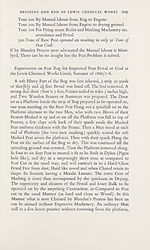Series 4 > Scottish industrial history
(253) Page 208
Download files
Complete book:
Individual page:
Thumbnail gallery: Grid view | List view

208
SCOTTISH INDUSTRIAL HISTORY
Expressed the opinion That the Creed Works Now was the com-
pletest yet erected for the Distillation of the Crude Hydrocarbon
Oils from Peat, Predicted its failure For want of a Chemist able to
Mix Chemicals and Utilize the Byproducts etc Going to waste.
Being supplied By Sir James Mathison Bt with all Publications
refering to the Utilization of Peat at Home and abroad. The Irish
Peat Co Work was the most conspicuous. Its History (Illustrated)
showed it to have been an elaborate and extensive Work. Its Failure
caused by the Great hight of the Kiln The Gases having to traverce
through a Mass of Peat 32 feet from the Hearth to the outlet, re¬
sulting in the Gases being Partly Condenced inside the Kiln in
stead of in the Very elaborate Condencers. Dr Paul avoided this
error, By Building 10 Kilns their aggregate Capacity not quite
equal to half the one Irish Kiln, The two Gas outlets in each Kiln,
one 3 feet and one 6 feet above the Fire Grates, led the Gases quickly
in to the Condencers. In place of 32 feet as In the Irish Peat Go’s
Work.
In the Sixties From 1862 to 1868, Termed the Coal Famine,
Innumerable Papers Published, and Patents taken out for Machinery
to Convert Peat into Charcoal, Peat Coal, and Ellumenating Gas
from Peats Giving as a precedent what was done with Peat on The
Continent, Quite overlooking the Difference of Climate for Drying
as compared to the United Kingdom. At that time, The principal
of what is now in 1895 advocated as a new descovery termed the
Blmdens Process for the Manufacture of Peat Coal (See Land and
Water, 12 January 1895) was well known 33 years since, as may be
seen in the records of the British Association of that Period Where
the subject was discused at length. The principal then and now
advocated is to Mash (by Machenery) the raw Peat braking up the
Fibers, Grass roots etc doing away with their resistance to the
Contraction of the Peat when exposed for drying etc. resulting in a
very supereour Peat Fewel (See farther on). The Practical objection
to Machenery being used for Mashing was the Large quantity of
Raw Peat to be Handled as compared with the Improved Peat
Fewal manufactured.
Thus Peat Bog Contains on an Average
70 percent of Water, 30 percent Fewal
30 percent Improved Fewal, Peat Coal
SCOTTISH INDUSTRIAL HISTORY
Expressed the opinion That the Creed Works Now was the com-
pletest yet erected for the Distillation of the Crude Hydrocarbon
Oils from Peat, Predicted its failure For want of a Chemist able to
Mix Chemicals and Utilize the Byproducts etc Going to waste.
Being supplied By Sir James Mathison Bt with all Publications
refering to the Utilization of Peat at Home and abroad. The Irish
Peat Co Work was the most conspicuous. Its History (Illustrated)
showed it to have been an elaborate and extensive Work. Its Failure
caused by the Great hight of the Kiln The Gases having to traverce
through a Mass of Peat 32 feet from the Hearth to the outlet, re¬
sulting in the Gases being Partly Condenced inside the Kiln in
stead of in the Very elaborate Condencers. Dr Paul avoided this
error, By Building 10 Kilns their aggregate Capacity not quite
equal to half the one Irish Kiln, The two Gas outlets in each Kiln,
one 3 feet and one 6 feet above the Fire Grates, led the Gases quickly
in to the Condencers. In place of 32 feet as In the Irish Peat Go’s
Work.
In the Sixties From 1862 to 1868, Termed the Coal Famine,
Innumerable Papers Published, and Patents taken out for Machinery
to Convert Peat into Charcoal, Peat Coal, and Ellumenating Gas
from Peats Giving as a precedent what was done with Peat on The
Continent, Quite overlooking the Difference of Climate for Drying
as compared to the United Kingdom. At that time, The principal
of what is now in 1895 advocated as a new descovery termed the
Blmdens Process for the Manufacture of Peat Coal (See Land and
Water, 12 January 1895) was well known 33 years since, as may be
seen in the records of the British Association of that Period Where
the subject was discused at length. The principal then and now
advocated is to Mash (by Machenery) the raw Peat braking up the
Fibers, Grass roots etc doing away with their resistance to the
Contraction of the Peat when exposed for drying etc. resulting in a
very supereour Peat Fewel (See farther on). The Practical objection
to Machenery being used for Mashing was the Large quantity of
Raw Peat to be Handled as compared with the Improved Peat
Fewal manufactured.
Thus Peat Bog Contains on an Average
70 percent of Water, 30 percent Fewal
30 percent Improved Fewal, Peat Coal
Set display mode to:
![]() Universal Viewer |
Universal Viewer | ![]() Mirador |
Large image | Transcription
Mirador |
Large image | Transcription
Images and transcriptions on this page, including medium image downloads, may be used under the Creative Commons Attribution 4.0 International Licence unless otherwise stated. ![]()
| Scottish History Society volumes > Series 4 > Scottish industrial history > (253) Page 208 |
|---|
| Permanent URL | https://digital.nls.uk/126658047 |
|---|
| Description | Over 180 volumes, published by the Scottish History Society, containing original sources on Scotland's history and people. With a wide range of subjects, the books collectively cover all periods from the 12th to 20th centuries, and reflect changing trends in Scottish history. Sources are accompanied by scholarly interpretation, references and bibliographies. Volumes are usually published annually, and more digitised volumes will be added as they become available. |
|---|


